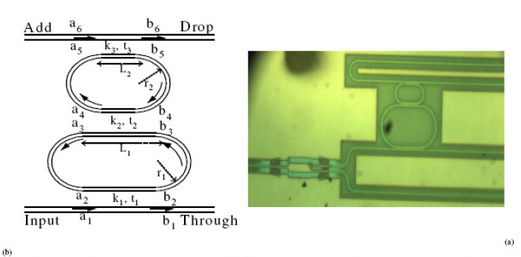In recent years, ring and racetrack resonators in SOI technology have been under intense investigation to exploit their versatile applications in communications and sensing. Among most of the applications, a large FSR of the resonator of a DWDM system is always desired in order to increase the number of channels that could be multiplexed or demultiplexed. However, FSR is inversely proportional to the optical length of the resonator structure and, therefore, to increase the FSR, the total length of the resonator must decrease, which in turn, increases the bending losses, i.e., decreases the Q factor. By the way, when dimensions of the resonators are enough small as nano-cavities, the resonators can reach no-stop band optical response with extremely high FSR and high Q-factor.
One solution to this problem is to use the Vernier effect of the series-coupled resonators with different optical length, thus to extend the FSR without decrease of the total length of the resonator structure. Actually, there are some papers reported about Vernier effect, however, few detailed and thorough simulations of Vernier devices, for example, in the ref. (2), the simulation is based on a 2-D finite difference approach.
In order to increase the number of channels that could be multiplexed or demultiplexed in the dense wavelength division multiplexed (DWDM) system based on the resonators on silicon-on-insulator (SOI) technology, the Vernier effect in the series-coupled racetrack resonators is presented to extend the free spectral range (FSR) of the DWDM systems. A method is developed based on a matrix approach to simulate Vernier devices. A three-dimensional full vectorial finite difference (FVFD) model, specifically suited for high index contrast and smaller size waveguides, for example, a waveguide in SOI technology, is developed to obtain the properties of a waveguide. Finally, the Vernier effect in the two series-coupled racetrack resonators is experimentally verified with an improved FSR and interstitial resonance suppression.

The calculation structure (a) and the optical photograph (b) of the two series-coupled racetrack resonators showing Vernier effect
Infrared Physics & Technology, 2014

